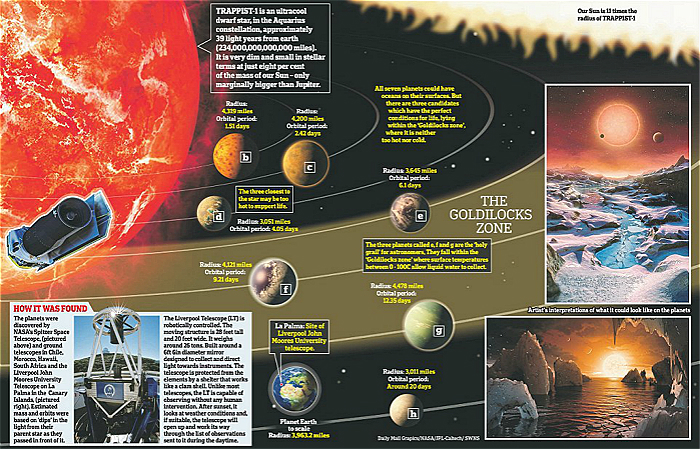For centuries it has been one of the most vexing mysteries for mankind: are we, the seven billioninhabitants of this wondrous [en]blue planet really alone, or is there life somewhere out there in the universe?
数百年来,人类一直为一个最大的谜团所困扰:我们这70亿生活在这个奇妙的蓝色星球上的居民,真的是孤独的吗,还是宇宙某处其实存在着生命?

Several days ago, we came a step closer to answering that tantalising question with the landmarkannouncement by Nasa scientists of the discovery of a new solar system that has at least three Earth-like planets — with climates that just might support life.
几天前,NASA科学家公布了一项里程碑式的重大发现:他们发现一个新的太阳系,其中至少有3个地球这样的行星,而且这些星球上的气候条件也许能维持生命,这项发现使我们离谜题的答案又近了一步。
The intriguing new planets are comparatively near neighbours, too, at just 39 light years from Earth. Granted, 39 light years (234 trillion miles) is hardly a short hop.
相比之下,这些迷人的新行星也算是我们的近邻,距地球只有39光年。当然,39光年(234兆英里)也很难看作“骐骥一跃”(连光都要走39年呢)。

Scientists have long speculated that life-supporting planets must exist somewhere in the universe, but none has ever yet been confirmed as potentially life-sustaining. Now astronomers say they have detected no less than seven Earth-sized worlds orbiting a red dwarf star — the equivalent of our sun — called TRAPPIST-1.
长久以来,科学家们推测宇宙某处一定存在着能支持生命的星球,但没有什么潜在的可维持生命的证据是坐实的。现在,宇航员们说他们已经探测到不少于7个地球大小的世界在一颗红矮星外的轨道上运行,这颗红矮星相当于我们的地球,被称作TRAPPIST-1.
The seven planets are believed to be at least a billion years old and, in theory, all could have lakes and oceans. But three are too close to the star and, therefore, likely to be too hot to have water, while the furthermost planet is too cold.
据信,这7颗行星至少已有10亿年历史,从理论上讲,这些行星上都可能有湖泊和海洋。但是,其中3颗离恒星太远,因此可能温度太高没有水,而最远的一颗行星又太冷了。
It is the three planets in the middle (named TRAPPIST-1 'e', 'f' and 'g') that are generating the most interest as they lie in what is known as the habitable 'Goldilocks Zone' — neither too hot nor too cold for life to thrive.
人们对中间的3颗行星(名为TRAPPIST-1 'e'、TRAPPIST-1 'f'和TRAPPIST-1 'g)兴趣最大,因为它们处于有名的适居的“金发区”——既不太热,也不太冷,适合生命繁衍。
The announcement yesterday prompts another intriguing and much debated question: if there is intelligent alien life on a planet orbiting TRAPPIST-1, why hasn't it made the effort to get in touch with us or even come visiting?
昨天公布的发现又引发了另一个困惑难解、莫衷一是的问题:如果在TRAPPIST-1轨道的一颗行星上存在有智慧的外星生命,那么他们为什么没有努力与我们联系甚至来地球作客呢?
This is the famous conundrum dubbed the 'Fermi Paradox'. Back in the Forties, the renowned Italian physicist Enrico Fermi suggested that, with 100 billion stars in our galaxy, it was logically inevitable that intelligent life should have evolved elsewhere in the universe. So, Fermi asked, where are all the aliens?
这就是有名的谜题——“费米悖论”。早在上世纪40年代,著名意大利物利学家恩里科•费米就提出:我们的星系中有1千万颗恒星,从逻辑上讲,宇宙某处应该不可避免地演化出了智慧生命。所以,费米问道:外星人在哪里呢?
Yet 40 years of intensive searching for extra-terrestrial intelligence has yielded nothing. No radio signals, no credible spacecraft sightings, no close encounters of any kind.
然而,40年集中的星外智慧生命搜索之旅颗粒无收。没有无线电信号,没有可靠的星际飞行物目击,没有任何形式的近距离接触。
Geoffrey Miller, an evolutionary psychologist at the University of New Mexico, has proposed a disturbinganswer. Perhaps there is a limit to how sophisticated a species can become.
新墨西哥大学的进化心理学家杰弗里•米勒提出了一个令人迷惑的答案。也许,物种演化的高级程度是有上限的。
We become smart enough to make nuclear bombs — and dumb enough to use them, he says. Or perhaps we just get addicted to social media and computer games, Miller suggests facetiously.
他说:我们已变得聪明到能制造核弹,却又笨到不知如何使用它们。米勒开玩笑说,也许是因为我们太沉迷于社交网络和电脑游戏了。
'The aliens may forget to send radio signals or colonise space because they are too busy with runawayconsumerism and virtual reality narcissism . . . just as we are doing today,' he says.
他说:“也许外星人忘了发射无线电线号或者在太空中开拓疆域,因为他们太忙了,正在疯狂购物,陶醉于虚拟现实之中……就像今天的我们。”

新年伊始,听说有好多同学声称自己去年的读书li...

不知是不是因为今年疫情的缘故,总觉得时间过得...

2020年即将过去,本年度的【好书荐读】系列也迎...
